Fiona, 36 Active wife & mother-to-five boys who fractured four vertebrae while hiking in New Zealand, ADELAIDE
Mother-to-five b oys, Fiona, 36, Adelaide, fractured four vertebrae from a fall while hiking in New Zealand on February 1, 2016 – a day after her wedding.
oys, Fiona, 36, Adelaide, fractured four vertebrae from a fall while hiking in New Zealand on February 1, 2016 – a day after her wedding.
As a result of her severe spinal injury, doctors arranged for Fiona to undergo a bone mineral density scan, which led to a subsequent diagnosis of osteoporosis.
Notably, Fiona has a strong family history of osteoporosis on both sides of her family.
This is Fiona’s story.
“After my fall, I experienced immediate and unbearable pain, and knew something was seriously wrong,” said Fiona.
“I’ve given birth to five children, but this was the most intense pain I’ve ever encountered.”
On February 1, 2016, while bushwalking on her brother-in-law’s property in New Zealand, and only one day after her wedding, Fiona slipped and landed on her back on some rocks.
Deep in dense bushland, Fiona’s husband immediately called for help, as his wife lay on her back, writhing in pain, and unable to move.
Unable to be evacuated by helicopter due to her difficult to access location, an ambulance drove as close to Fiona’s location as possible. For nearly five hours, an emergency crew carried Fiona on a stretcher to the ambulance.
When finally arriving at hospital, Fiona immediately underwent an X-ray that revealed she had fractured four vertebrae.
“Judging by my pain, and the fact that I couldn’t move, the doctors were fairly certain I had fractured my back. So they sent me for an X-ray to confirm their suspicions,” Fiona said.
“When they told me I had fractured four vertebrae, I was in shock.”
The doctors also enquired about Fiona’s family history of brittle bones.
“The first question the doctor asked me after my X-ray was whether I had a family history of osteoporosis, given the severity of the fractures I had sustained,” said Fiona.
He then arranged for Fiona to undergo a bone mineral density scan, which she had three weeks later, while continuing to mount her recovery in New Zealand.
“I was referred to a different doctor in New Zealand to conduct the bone mineral density scan, and it was he who diagnosed me with osteoporosis. I was in such a state at the time, and on strong pain medication, that I don’t recall too much about my diagnosis.”
Fiona had long suspected she was at risk of osteoporosis, given her strong family history of the bone disease.
“My father, both of his siblings, and his mother were all diagnosed with osteoporosis, and several of my cousins on dad’s side are also living with the disease.
“My mother and grandmother, both of whom have who have passed away, each developed a dowager’s hump, and often battled back pain. I’m not certain whether they were diagnosed with osteoporosis, but I definitely suspect they were living with the disease,” Fiona said.
“Given my family history of osteoporosis, I suspected the bone disease was something with which I would have to contend eventually.”
Fiona’s osteoporosis has restricted her from performing various activities.
“I have five sons ranging in age from 12 months to 13 years, all of whom collectively have a lot of energy.
“I used to be able to join in their activities. Only recently however, some of my boys were playing on the trampoline, when they asked me to come and jump with them, and I had to decline,” said Fiona.
Nowadays, Fiona is acutely aware of her heightened risk of fracture, and recognises her limitations. She was planning to take a trip around Australia over the ensuing year with her husband, who works on a fly-in-fly-out basis, and her children. However, after fracturing her spine, and given her increased risk of further fracture, she has had to come to terms with the fact that this trip will no longer occur according to her original plans.
Post- her fall, Fiona’s husband was forced to take leave from work to care for Fiona during her initial rehabilitation. Given she is restr icted from carrying certain weights, she has also had to hire a nanny full-time to support her with managing her children 24/7.
icted from carrying certain weights, she has also had to hire a nanny full-time to support her with managing her children 24/7.
“It’s been really tough, and I’m still recovering from my spinal fractures.
I’ve had to stop breast feeding, and I can’t even carry my baby. Only this month (June 2016), have I been able to sit on the floor and hold him on my lap. For the past four months, I haven’t even been able to do that,” Fiona said.
Today, Fiona is working with an Adelaide-based endocrinologist on a treatment plan, and has also spoken to her GP about a care plan, which involves meeting up to five times with an exercise physiologist, and visiting a physiotherapist to help minimise her risk of injury.
Fiona has also had to cut back on her regular yoga classes, for many of the exercises carry the risk of further damaging her spine. Instead, she has taken up pilates in order to strengthen her bones, and has joined a Facebook support group for younger people living with osteoporosis.
“There hasn’t been much research from what I’ve seen, involving younger people and osteoporosis.
“I do however, think it’s really important for all adults to be aware of osteoporosis and their risk of sustaining a fracture,” said Fiona.
“In particular, women like me who have a family history of the disease, and young mums’ who are breastfeeding their babies, should be aware of their risk of developing osteoporosis and how to ward off potential fractures.”
Fiona recently lear ned about the new Know Your Bones health assessment tool – an inaugural Garvan Institute of Medical Research and Osteoporosis Australia initiative that predicts the likelihood of fractures for adults, including those living with osteopenia (a precursor to osteoporosis) and osteoporosis. The evidence-based, online fracture risk self-assessment allows the user to predict their risk of bone fracture, which they can print out and take to their GP for further discussion, investigation and treatment, if required.
“This is a fantastic tool which I genuinely hope gets widely publicised and shared among Australian adults.
“Osteoporosis is not just an older person’s disease – it can affect people of all ages. So a tool like this can prevent fractures resulting from poor bone health by allowing the consumer to be proactive about their bone health,” Fiona said.
